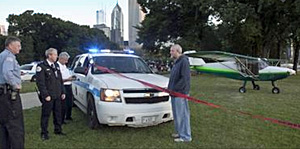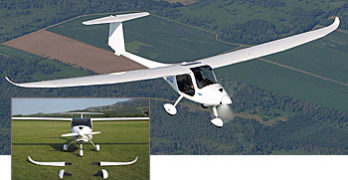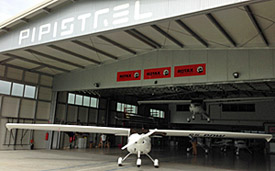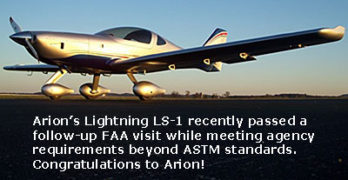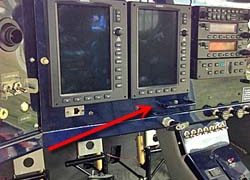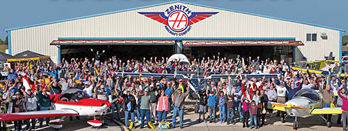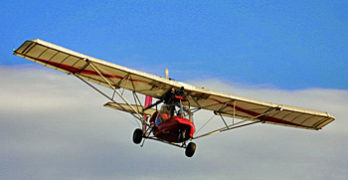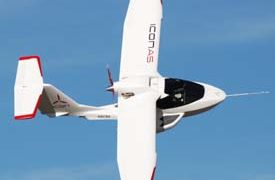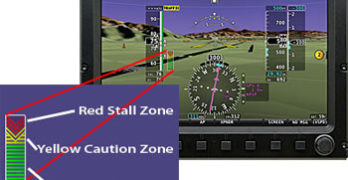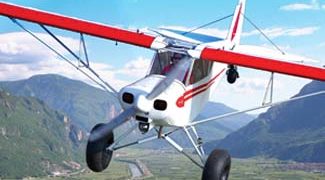After losing the trim tab on the elevator of his Rans S-6, John Pederson of Lombard, Illinois grappled with a violent shaking and executed an emergency landing on Chicago’s Lake Shore Drive. He was flying very early so traffic on the multi-lane route was light. Pederson reported timing his landing to avoid any traffic, though local sources reported the airplane was struck by two autos both of which sped away afterward. Unable to regain stability, the 51-year-old electrician radioed a mayday to O’Hare International Airport and then set up for landing. A recording of the radio call revealed John behaving calmly and, indeed, no one was injured in the highly-publicized incident. “At the time of the mayday call, about 6 a.m., he was flying about 1,900 feet above [Chicago’s downtown] Millennium Park, he said,” according to a report on the Chicago Tribune‘s online website.
The good news is no one was injured and while media reports poked fun at Pederson’s very visible downtown Chicago landing, the report can nonetheless be viewed more or less positively.
Pipistrel’s Flexible Sinus & Soarable Taurus
After Germany’s Aero 2013 event, we traveled to Pipistrel. It was our first visit to Slovenia, a country of four million with a section of the Alps running through it and a lovely route called the Emerald Trail to view the tall mountains. Slovenia proved a beautiful country that we’d love to visit again, but a leading reason to repeat is the presence of Pipistrel. This summer, the LSA and self-launched glider producer is in the news with their exchangeable wingtip Sinus Flex that transforms the long, shapely motorglider wings from a 50-foot span to a more hangar-manageable 40 feet. Using a single bolt, the change is said to take only five minutes and the unused tips can be stored in leather bags; the option price is $5,200. Buyers get both “a long range super-economic cruiser” and a “training aircraft,” noted Pipistrel. Sinus offers dual flight controls and a choice of either tailwheel or nosewheel gear, though the latter decision must be made at purchase.
After Aero — Visiting Rotax and Pipistrel
We paid two memorable visits after Aero ended and I’ll tell you a little about each one … but first … While I was at Pipistrel in the office of boss Ivo Boscarol, he received word that Matevz Lenarcic had reached the North Pole on his flight reported earlier. Congratulations on this achievement; a long flight across the North Atlantic remains. Godspeed! ••• The two visits were to Rotax Aircraft Engines and to Pipistrel. These two are not geographically far apart and work closely. Each spoke highly of the other and both companies are highly impressive places to visit.
BRP-Powertrain is the parent behind Rotax Aircraft Engines. Though occupying a sizeable amount of real estate in the immense BRP-Powertrain factory, the aircraft engines are the “hand built” portion of the production. Fast-paced, largely-automated, robot-assisted assembly lines manufacture many thousands of engines each year for such products as SeaDoo, BMW motorcycles, and other well-known brands.
Simple Aircraft (Like LSA) Need Simple Rules
In this post I’m going to do something potentially risky. I am going to make some statements about the politics of aircraft certification. While rather dull, this subject is nonetheless something pilots and others feel rather strongly about as the safety of aircraft — for persons in or under aircraft — is involved. Doesn’t everyone except a handful of thrill seekers care deeply about safety? I certainly do yet I feel it’s time for some new directions. I fully expect not everyone will agree, but I feel strongly that these statements need to be made. So, here goes …
My term as Membership Secretary of ASTM’s F37 LSA committee will complete later this year; I will be term limited out. That’s perfectly fine … I’ve done my duty for several years. ASTM’s F37 committee is the group that wrote and updates the standards used to gain acceptance for Light-Sport Aircraft. F37 is populated by some exceptional people that are largely unsung heroes for all the hard work they’ve done with little recognition.
Oshkosh 2013 Elements, Part 3: Slide-Out Panel
Elements are basic components of nature. As in our first two parts, I see Oshkosh Elements as worthy ideas other than airframes or engines. One such is World Aircraft Company‘s roller-bearing pull-out drawer instrument panel. Now, if you are like me and don’t spend a lot of time around your airplane with a wrench or soldering iron in your hands, you might not see why this is important. For panels with a collection of round instruments, maybe it isn’t as fetching an idea. Yet I’m willing to guess that nearly every mechanic who reads this or hears of World’s innovation is going to say, “Yes! Why hasn’t this been done before and why aren’t all instrument panels done this way?”
Early this year, I watched while two avionics mechanics maneuvered around the instrument panel in a Flight Design CTLSi. Their task was to install ADS-B hardware to coordinate with the dual-screen Dynon SkyView that fills left and right bays of the instrument panel.
Zenith Opens Its Hangar to Big Crowds
We interrupt our series on Oshkosh Elements to highlight the upcoming Zenith Open Hangar Day. The event taking place on Saturday, September 21, 2013 is the company’s 22nd annual such event and it draws a large crowd as you can see in last year’s photo. Normally, one company opening its doors to customers and visitors is not big news but Zenith has done particularly well with their open house. For many recent years, Zenith has steadily been delivering kits at the rate of about 200 units per year, a volume most airframe makers would love to match and one that puts Zenith near the top of the list (if not the alphabet). It means the company has developed a large following and, when invited, they turn out. Given the focus on the Midwest LSA Expo at the beginning of September, one could say the Midwest will be active region for LSA and light kit enthusiasts.
Oshkosh 2013 Elements, Part 1: King Paul Mather
Elements are basic components of nature. I intend Oshkosh Elements to be great ideas that are not airframes or engines. I found a few activities or ideas worthy of inclusion in this multipart series. To begin, many folks understand various forms of competitions happen at these big shows. Many aircraft are judged for their building or restoring achievements. Others participate in races or airshow routines. And, of course, all vendors compete for the dollars of visitors. In another informal competition, aircraft vendors try to deliver lots of demonstration flights. I’ve heard tales about this for years. At AirVenture 2013, Progressive Aerodyne‘s Kerry Ritcher, designer and pilot extraordinaire of the SeaRey, told me about flying so many demo flights in 2012 that his team brought him sandwiches to wolf down in the airplane while they loaded another person in the passenger seat. He didn’t even have time to get out for a stretch.
Icon Gets Its Weight Exemption
Important FAA-related message at end of this article.
Opening day at AirVenture Oshkosh 2013 and the very first announcement before exhibit spaces even opened was a press conference from Icon Aircraft. To a media-only group of perhaps 30 or 40 media personalities, CEO Kirk Hawkins began, “Is there anyone here who doesn’t know what this about?” No one responded; everyone knew what the rumor mill had begun spewing. Icon is in good company. Even premiere new product secret-keeper, Apple Inc., has trouble announcing something that no one expected. Yet a few comments from the top gun at Icon were of special interest. One other observation first: it was a media event, but if even a single FAA person was in attendance, they were under cover. No FAA shirts or badges could be spotted. Thus Icon made their announcement without any active FAA participation.
Icon received Grant of Exemption No. 10829 for a weight increase with FAA stating,”The combined features and SRA (Spin Resistant Airframe) incorporated into the Icon A5 design … are recognized by the FAA as significant safety enhancements.” FAA also referenced that the agency felt an exemption was “in the public’s interest.” Kirk Hawkins added that his engineers “put safety ahead of arbitrary weight limits” and forged ahead with enhancements to include a more crashworthy cockpit, the airframe parachute (about which they’d already talked but with which the weight increase became more possible), and of course, the wing cuffs, “a synthesis of several known ideas put together in a way that finally worked” to provide a Part 23-worthy stall resistant airframe.
Avionics World: Changes for Your Panel
Dynon gathers little moss it appears. The SkyView builder has been upgrading software, releasing new products and now, the Woodinville, Washington company has acquired Advanced Flight Systems (AFS). Dynon said they did the acquisition, “… to use Dynon’s financial strength to keep AFS strong and vibrant in the experimental community.” It appears to be a pure financial move as the two companies will continue to operate with full autonomy, according to a Dynon FAQ series. • Another reason to buy a former “friendly competitor” is to get more deeply involved with Angle of Attack (AoA) indicators, which are causing a significant buzz. “AFS holds patents on Angle of Attack (AoA) technology and has long been a leader with AoA products,” reported Dynon. As you’ll read below, Icon is pushing the instrument and others are singing the praises of AoA, yet fighter aircraft and airliners have had the technology for years.
Super Duper Stroker from the S-Planes Company
The go-up-faster competition in Light-Sport aviation just got more boisterous. SportairUSA loves their S-planes and they just announced a new one: Cub-S. Why do I call them the S-planes people? How about this? They sell the Sting, Sirius, Savage, Snap, and now Cub-S with the Titan Stroker IO-340 engine producing a whopping 180 horsepower. The company is SportairUSA, U.S. distributor for aircraft manufactured by Zlin Aviation of the Czech Republic and they plan to showcase their new Cub-S at AirVenture 2013. “Look for the SportairUSA site at #295 Knapp Road, located just off of Celebration Way, between the Lycoming display and the EAA Welcome Center, said the company publicist. Here’s another company using Lycoming engines, a move we’ve increasingly seen in the last couple years, adding to Renegade, Arion Aircraft, and Tecnam.
“With its best-in-category power-to-empty weight ratio of 4.74 pounds per horsepower (7.33 pounds per horsepower even at MTOW), the Cub-S climbs at up to 2,100 fpm,” said Bill Canino of SportairUSA.
- « Previous Page
- 1
- …
- 17
- 18
- 19
- 20
- 21
- …
- 64
- Next Page »


